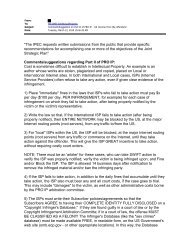We Energies Coal Combustion Products ... - The White House
We Energies Coal Combustion Products ... - The White House
We Energies Coal Combustion Products ... - The White House
You also want an ePaper? Increase the reach of your titles
YUMPU automatically turns print PDFs into web optimized ePapers that Google loves.
Roller Compacted No-Fines Concrete<br />
Containing <strong>We</strong> <strong>Energies</strong> Fly Ash for Road<br />
Base Course<br />
Many problems associated with pavement failure are due to the pressure of<br />
water under rigid surface pavements. When high pressure from heavy traffic is<br />
applied on pavements in the presence of water, pumping occurs. Pumping<br />
causes erosion of the pavement base, as fines along with water are pumped<br />
out. <strong>The</strong> continued effect of pumping is a loss of support, leading to pavement<br />
failure. An open-graded permeable base is used to avoid such problems. <strong>The</strong><br />
open-graded permeable base pavement system consists of a permeable base,<br />
separator layer and edge drainage. Permeable bases can be treated or untreated<br />
with cementitious binders.<br />
A demonstration project was designed to use an off-spec ASTM C618, Class<br />
F fly ash in the open-graded concrete base course and an ASTM C618 Class C<br />
fly ash in the concrete pavement for an internal road at the Port Washington<br />
Power Plant located in Port Washington, Wisconsin.<br />
<strong>The</strong> roadway cross section (see Figures 4-25 and 4-26) consisted of an initial<br />
layer of filter fabric installed to prevent fines from the subgrade moving up<br />
and blocking drainage in the base course, topped by a 6” thick layer of opengraded<br />
concrete base course and a 10 in. thick, high-volume fly ash concrete<br />
pavement. This pavement was designed in compliance with Wisconsin DOT<br />
standards, with the exception of using high-volume fly ash in the open-graded<br />
base, and concrete pavement. Underdrains, manholes and storm sewer piping<br />
were also installed as part of this project, to ensure proper functioning of the<br />
pavement system (32).<br />
<strong>The</strong> properties of fly ash and cement used in this project are shown on<br />
Table 4-41. <strong>The</strong> ASTM C618, Class F fly ash used on the project is offspecification<br />
with a very high LOI.<br />
<strong>The</strong> mixture proportions for the open-graded base course were composed of<br />
160 lb./cu. yd. cement, 125 lb./cu. yd. fly ash, 81 lb./cu. yd. water,<br />
2600 lb./cu. yd. ¾ in. coarse aggregate and no fine aggregate.<br />
<strong>The</strong> mixture proportions for high-volume fly ash concrete pavement included<br />
300 lb./cu. yd. cement, 300 lb./cu. yd. Class C fly ash, 221 lb./cu. yd. water,<br />
1200 lb./cu. yd. sand, 966 lb./cu. yd. ¾” aggregate and 966 lb./cu. yd. 1½”<br />
coarse aggregate. <strong>The</strong> water to cementitious materials ratio was maintained at<br />
about 0.37.<br />
<strong>We</strong> <strong>Energies</strong> 108<br />
<strong>Coal</strong> <strong>Combustion</strong> <strong>Products</strong><br />
Utilization Handbook



